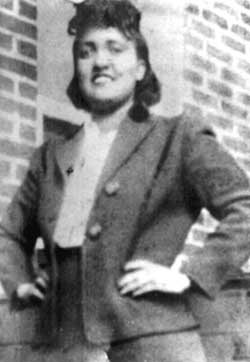Have you ever heard of Henrietta Lacks? In many respects, she was an ordinary woman. Born on August 1, 1920, she gave birth to five children, but only lived 31 years. But she had a profound effect on modern science and, at least indirectly, has saved many lives.
The rem arkable part of her story began on January 29, 1951, when she went to Johns Hopkins Hospital in Baltimore because she could feel a lump in her womb. The lump was cervical cancer, which spread throughout her body and led to her death on October 4, 1951. As part of the procedure of the time, a biopsy of the lump was taken and given to George Otto Gey. Normally these cells quickly die, but much to everyone’s surprise, Henrietta’s cells thrived when cultured. Henrietta was the source of the first immortalized cell line, which means they reproduce indefinitely under the right conditions. The medical part of the story gets a bit technical, but an immortalized line is invaluable for medical research. Gey developed them into a cell line he called HeLa, and he distributed them freely to the medical community. The resulting contribution to medicine is virtually incalculable; for examp
arkable part of her story began on January 29, 1951, when she went to Johns Hopkins Hospital in Baltimore because she could feel a lump in her womb. The lump was cervical cancer, which spread throughout her body and led to her death on October 4, 1951. As part of the procedure of the time, a biopsy of the lump was taken and given to George Otto Gey. Normally these cells quickly die, but much to everyone’s surprise, Henrietta’s cells thrived when cultured. Henrietta was the source of the first immortalized cell line, which means they reproduce indefinitely under the right conditions. The medical part of the story gets a bit technical, but an immortalized line is invaluable for medical research. Gey developed them into a cell line he called HeLa, and he distributed them freely to the medical community. The resulting contribution to medicine is virtually incalculable; for examp le, this cell line performed a critical role in the development of the first polio vaccine. HeLa S3 cells are shown at right (https://www.flickr.com/photos/8674020@N04/5420346423/in/photolist-9fYG9F-dYxbuo-dZVM8G).
le, this cell line performed a critical role in the development of the first polio vaccine. HeLa S3 cells are shown at right (https://www.flickr.com/photos/8674020@N04/5420346423/in/photolist-9fYG9F-dYxbuo-dZVM8G).
It was a simpler time. No consent was ever obtained from Henrietta or her family to establish the cell line, and Gey received no compensation for distributing HeLa. This has cause some anguish for the family when they ultimately realized what had happened. The good news is Henrietta is finally getting some recognition — The Immortal Life of Henrietta Lacks is a biography written in 2010 by Rebecca Skloot, and the book has been turned into a TV movie starring Oprah Winfrey; it was released on April 22, 2017 on HBO.
A Radiolab podcast is available at http://www.radiolab.org/story/radiolab-extra-henrietta-lacks/ . Henrietta’s portrait is from Wikipedia (https://en.wikipedia.org/wiki/Henrietta_Lacks).
It’s it amazing the difference one person can make?
